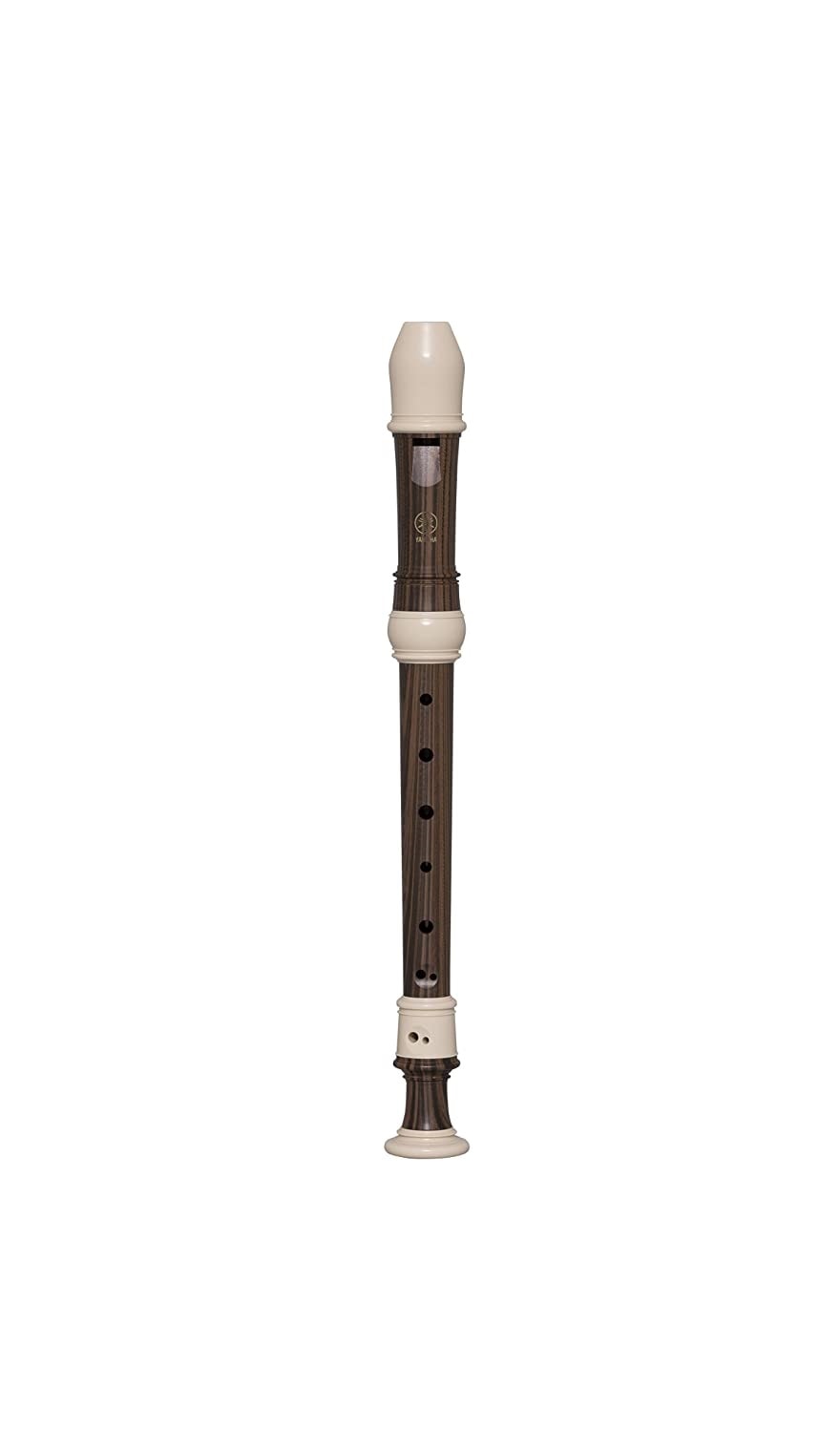- Top Trumpet Embouchure Techniques: Options for Beginners Through Professionals - October 12, 2022
- Is the Trumpet Hard to Learn? - September 30, 2022
- Best Leblanc Clarinet Models Guide: From Soprano to Contrabass - September 5, 2022
Did you know that Mozart didn’t write his flute concertos for the instrument we play today? The history and types of flutes have evolved over the past couple of centuries, but they’ve been around for millennia. If you’re a flute nerd like me, you may want to know the history of the instrument. Not only can it help you improve your playing, but you’ll have plenty of fun facts to share at parties.
So, do you want to become the next flute star? Brush up on your flute history first.
The History Of Flutes
The flute is one of the oldest musical instruments in the world, though not in its current form. People have made flutes out of tons of materials and used different designs throughout the centuries.
Whether you’re new to the flute or have played it for a while, you should have a basic understanding of the flute’s history.
Prehistoric Flutes
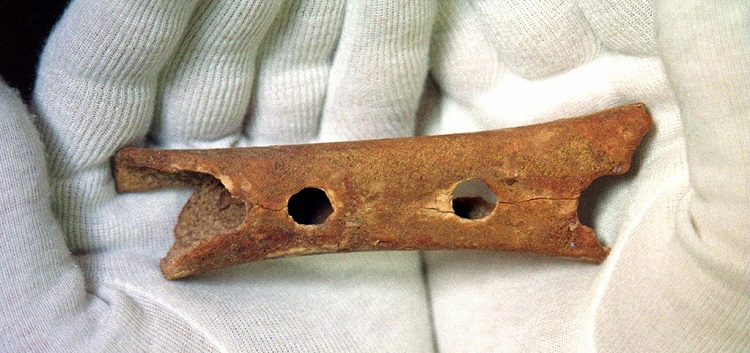
Scientists have dated the oldest flutes at about 42,000 to 43,000 years old. Explorers found these flutes in southern Germany in a cave. Mammoth ivory and bird bones were the materials of choice by early humans. When they made the instruments, they carved a couple of holes, so they could produce different notes.
They blew into the edge of the flute to make a sound, so it’s similar to the modern recorder. And flutes only kept evolving from here.
Baroque Flutes
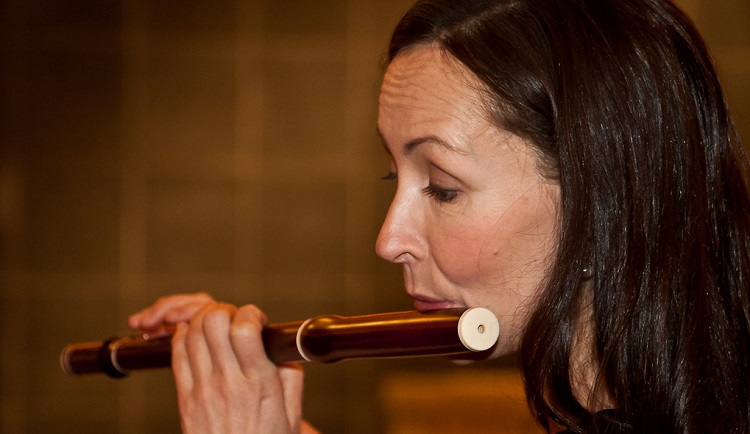
The Baroque era lasted from 1600 to 1750, and the flute got a big upgrade during this time. Near the end of the 17th century, the Hotteterre family from France invented the Baroque flute, or traverso.
It was the first transverse (side-blown) flute with a similar design to today’s flute. While the Renaissance era had flutes, they weren’t as advanced as the Baroque instrument.
Baroque flutes were the first to have multiple sections instead of being one piece of wood. They also had one key that allowed players to produce an E flat, which was a semitone higher than the lowest note, D. The instrument became so popular that players resisted later changes to the design. Even today, many flute players own replicas of Baroque flutes to use when playing music from the era, such as pieces by J.S. Bach.
Keyed Flutes

During the early 19th century, multiple flute makers developed the flute more. They started to add up to eight keys to help play more notes within the scale of the instrument. Modern flute makers continue to make keyed flutes by following the original designs from makers such as Heinrich Grenser, Stephan Koch, and Theobald Boehm.
Some flutes had four or six keys, and each maker used slightly different designs. Certain designs even extended the flute’s range down to a low C or B, which is what it is today.
Boehm Flutes
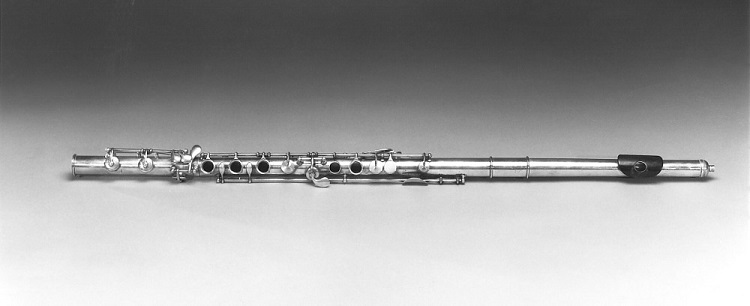
The main type of flute that people play today is the Boehm flute. Theobald Boehm worked as a musician and flute maker, and he originally made keyed flutes. When he visited London in the 1830s, he learned about some problems that the flutes had. Over about a decade, Boehm experimented with different designs until he found one that we know and love today.
His design changes included using metal instead of wood and making the tone holes bigger. The bigger tone holes required keys for players to close so that the flute would be playable.
Another major change was that Boehm used a cylindrical tube. Prior to that, flutes were conical, so the tube was slightly smaller at one end.
Types Of Flutes
The history of the flute doesn’t stop after Boehm’s initial design. Over the years, other flute makers continued to experiment with adding or changing keys. However, flute makers also expanded the range of the flute by adding different instruments to the family. I’ve played most of these flutes at least once, and they all have something unique to offer players.
Concert Flute
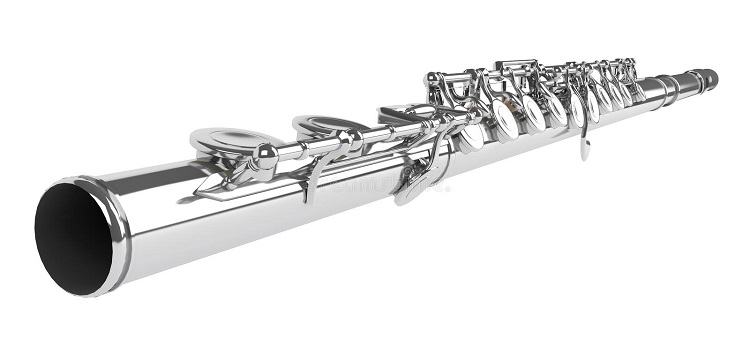
This is the flute that most of us think of when we think of a flute. It has three parts that you put together to play, and its range is middle C or the B right below it to the C three octaves higher or the D above that.
When you start to play the flute, this is probably the instrument you’ll learn first. Because of its long history, there are tons of pieces for the flute and at various playing levels. Flutes come in a variety of materials, including silver, gold, and wood. However, silver is the most common material for the modern concert flute.
The flute can even play in genres such as jazz and popular music. If you don’t like playing classical music, you can still play the flute.
Piccolo

The piccolo is the smallest member of the flute family, and it’s the highest-pitched member of the orchestra. It’s about half the length of the flute, and it players one octave higher. But it has the same written range as the flute, except its lowest note is D.
Many flute players will learn the piccolo either out of interest or necessity. If you can play the piccolo, you have better odds of joining a local or school orchestra. I, personally, love playing the piccolo, but I know a lot of flute players hate it. While it can be squeaky, it can also have fantastic solos and melodies.
And like flutes, piccolos come in various materials, including silver, plastic, and wood. You may not hear the piccolo in jazz or pop, and it isn’t as common as the flute, but it’s still fun to play. Just be sure to wear earplugs.
ETY-Plugs is the world's highest fidelity non-custom earplugs. They reduce most noise to safe levels while preserving the clarity of speech and the richness of music.
Alto Flute

Originally a bass flute in G, the alto flute has been gaining popularity over the past few decades. It hasn’t been around as long as the flute or piccolo, so there isn’t as much music for it. However, there are alto flutes in orchestral works, such as The Planets by Gustav Holst. There are also some solo and chamber works with alto flute parts, which are a fourth lower than the concert flute.
The alto flute is especially popular in flute choirs and flute orchestras. It functions as a tenor or lower alto voice, like the viola in a string orchestra. Alto flutes can have a straight headjoint like the concert flute. But curved headjoints are also common to help players with shorter arms reach the keys.
Alto flutes are mostly made of metal, with silver being the most common metal. However, you can also find alto flutes that use nickel, copper, or brass.
Bass Flute

Another low flute you should know is the bass flute. It plays an octave lower than the concert flute, but like the other members of the flute family, it reads the same notes on paper. Because of the size, bass flutes all have a curved headjoint to help players reach the notes. However, some bass flutes use a T design, which makes the flute vertical.
The vertical design can take some of the weight off of the player, so it can be easier to play. To help with balance, it has a peg that attaches to the flute while one end rests on the ground. Like alto flutes, bass flutes are common in flute ensembles, and they can play the bass line. Most bass flutes are silver, though some can be brass or nickel.
Contrabass Flute
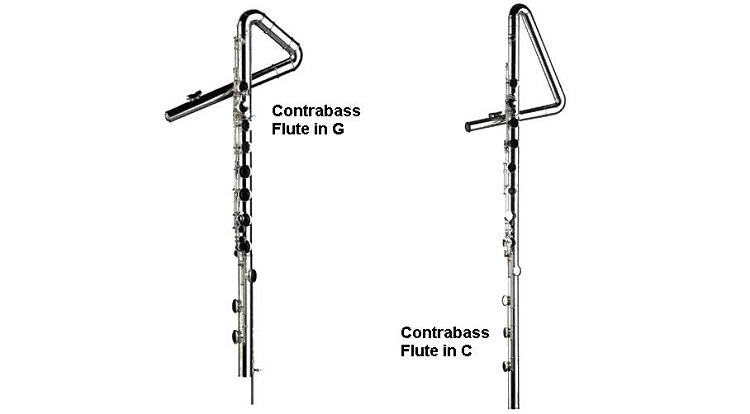
While not as common as the other flutes, the contrabass flute is worth knowing. It’s slowly becoming more popular due to the growth of flute choirs, where it acts like a double bass. The contrabass flute players two octaves lower than the concert flute, but it still reads the same notes when you use sheet music.
Since it’s so big, the instrument is usually shaped like the number 4, and the player has to stand. It has a peg, like the vertical bass flute, so you can rest it on the ground. This is one type of flute that I’ve never played, but I have seen them in person. They sound really cool, but they take a lot of air to play.
Less Common Flutes

The concert flute family has more members than you may think. By far, the most common are the flute and the piccolo. Some of the low flutes are also not that rare. But there are some less common members across the entire range of the family. Probably the most common of these is the D flat piccolo, which plays a half step above the common C piccolo.
Moving down, there’s also a G treble flute, which plays an octave above the alto flute. And there’s the E flat flute, which plays a minor third above the concert flute. Just below the concert flute, there’s the flute d’amore, which may be in B flat or A. An octave below the alto flute is the contra-alto flute, and the subcontrabass flute is an octave below that, also in G.
The next flute family member is the double contrabass flute, which plays an octave below the contrabass flute. Finally, one octave below that is the hyperbass flute.
Non-Concert Flutes
While the concert flute family is the most popular, there are other flutes from all around the world. Some of the flutes look like concert flutes and piccolos, while others are a bit different.
Instruments such as the fife are side-blown, and the recorder and similar flutes are end-blown. Here are some non-concert flutes that can be fun to play and learn.
Recorder
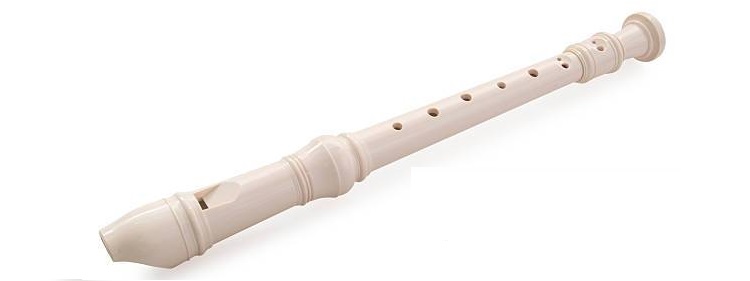
I know what you’re thinking. “The recorder is annoying. Only kids play it.” And you’re right, a lot of kids play the recorder, and it’s hard to make the recorder sound good. However, it can sound good when someone practices. And before the flute became what it is today, people called the recorder the “flute.”
The recorder uses a similar design to a flute when it comes to the finger holes. It doesn’t have any keys, so you can play it and maintain it yourself. Recorders also come in multiple sizes, such as the soprano, which is what kids usually play. The alto recorder is another popular variation, but recorders come smaller and bigger.
Fife

The fife looks the most like a flute, specifically a piccolo. You play it off to the side like you would a flute or piccolo, so it can be an easy transition. Fifes were very popular before piccolos gained prominence. Many military bands have used fifes as part of a fife and drum corps.
You can find metal fifes, but you can also buy a plastic fife, which is like a combination of the piccolo and the recorder. I own both types of fifes, and they’re fun to play when I want to play something simple. But the lack of keys does make it hard to play complex music. And the fingering system for the fife is different from the concert flute family.
The American Fife has been part of USA history since the days of George Washington. This fife, in the key of C, is made of durable Nickel-plated brass for years of enjoyment.
Tin Whistle

Another type of flute you can get for cheap and to play for fun is a tin whistle. It also goes by the name of the Irish whistle or the penny whistle. No matter what you call it, you blow into the end of the instrument. The fingering system is similar to that of a flute, but it doesn’t have any keys.
Its lowest note is D, though some fifes go down to C or even lower. I have two fifes in D and one in C, and the one in C is slightly longer than the ones in D.
Introducing Waltons Whistle Brass - Key of D! The very most common keys that tin whistles come in are C and D. Waltons Whistle Brass is most commonly found in Key D. Allowing you to play a wide variety of music as well as giving you the mellow tone and melody that you are looking for in a tin whistle!
Ocarina
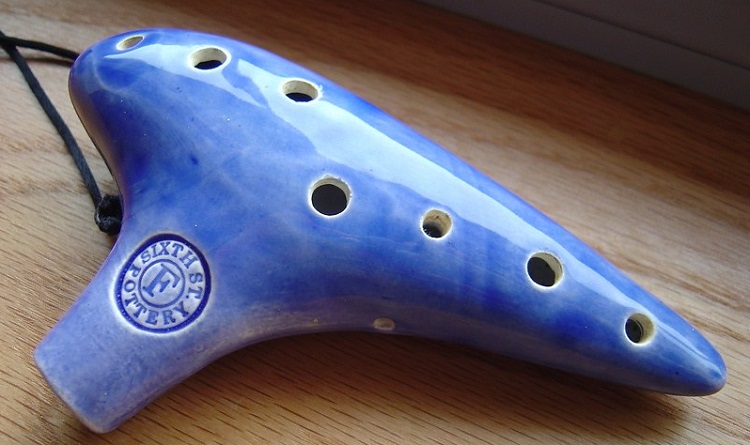
If you’ve ever played The Legend of Zelda, you’ve probably heard of the ocarina from the Ocarina of Time. But the instrument is more than part of a video game series. As with other types of flutes, ocarinas come in different sizes, and they come with different numbers of holes. The most common size is an alto, and it has 12 holes that you open and close to play.
I’ve also played ocarinas with as few as four holes. Those instruments may not be able to play as much, but they’re still fun to play.
The 12-hole Sweet Potato Ocarina, key of A4-F6, is tuned in the key of C and can go below C down to the A. This ocarina has exquisite breath response and crystal clear tone. It comes with a finger chart and a songbook.
Native American Flute

Another excellent world flute to know about is the Native American Flute. Like other types of flutes, it comes in different sizes and pitches, so you can play a bigger range of notes. Each flute can only play a few notes, and there aren’t any keys. Some Native American Flutes have five holes, while others have six.
I own one five-hole Native American Flute. I’ve never learned how to play it, but it’s fun to use to improvise.
Levels Of Flutes
Another thing to consider when looking at the types of flutes is the level and price range. You can find the cheapest flute on Amazon or eBay for $70 or less. On the other hand, some flutes cost as much as $84,000. Whether you’re looking to buy your first flute or need to upgrade, you should consider the different levels. Then, you can choose an instrument that suits your needs.
Beginner/Student Flutes

Beginner flutes are some of the most affordable and most durable flutes you can find. They tend to have the same specs, so you don’t need to think much about your choice. Beginner specs include:
- Nickel with silver plating
- C footjoint
- Closed holes
- Offset G key
You can find student flutes for around $1,000 or less. These flutes are perfect for when you first learn how to play because they’re easy to get a sound on.
Student flutes also use durable materials, so they can withstand nicks and scratches without affecting the sound. So you don’t have to hold the flute perfectly all of the time.
Beginner/Student Piccolos
If you want to play the piccolo, a beginner model is a good place to start. These piccolos are, like student flutes, usually more affordable than advanced models.
A beginner piccolo may be all silver plated and look like a small flute. Or it may have a metal headjoint and a plastic body. Other specs include:
- Range to low D
- Thumb and finger rests on metal bodies
- Metal lip plate
Student piccolos tend to cost around $800 to $1,000 if you buy one new. However, you can find plenty of used student piccolos for as little as $300.
Step-Up/Intermediate Flutes
The next level of flute includes intermediate models. If you need to upgrade from a student model, this is usually the way you’ll go.
Step-up flutes are a step up from the beginner level, so they have more features. The extra features can help you as you learn more complex pieces. Features include:
- Solid silver headjoint and/or body
- Handmade headjoint
- B footjoint
- Open holes
- Split-E mechanism
Intermediate flutes can cost anywhere from $1,200 to $5,000. The exact cost can depend on the specs and the manufacturer. Buying used can help you lower the price.
Step-Up/Intermediate Piccolos
Again, like flutes, you can upgrade to a better piccolo, but you don’t have to spend a ton of money. At this level, piccolos tend to have more specs, and some may even be wood.
You can also find plastic or composite piccolos. For example, the Pearl 105 piccolo is a composite model, which combines plastic and grenadilla wood to make grenaditte. Other step-up specs may include:
- Split-E mechanism
- Full wood headjoint and/or body
You may be able to find a step-up piccolo for about the same price as a student model. However, these piccolos can cost up to $3,000 or so.
The PFP-105E is made of a remarkable proprietary material, Grenaditte. Grenaditte is impervious to temperature fluctuations and maintains precise pitch and tonal center.
Professional Flutes
You don’t have to make money as a musician to play a professional flute. The name “professional” can apply to the player, but it also applies to the specs and design of the instrument.
Professional flutes tend to have more bells and whistles. They also have more options that players can choose from to customize the sound and feel of the instrument, such as:
- Silver, gold, and platinum
- Handmade headjoint and body
- C# trill key
- D# roller
- Thicker or thinner tubing
Another way you can customize a professional flute headjoint is with the cut of the embouchure hole where you blow. For example, my flute has a more rectangular embouchure hole, which works for me. But some players prefer an oval or circular hole.
A professional flute can cost as little as $5,000 or as much as $84,000. Some older models can go for lower than a new model if you buy them from the current owner.
Professional Piccolos
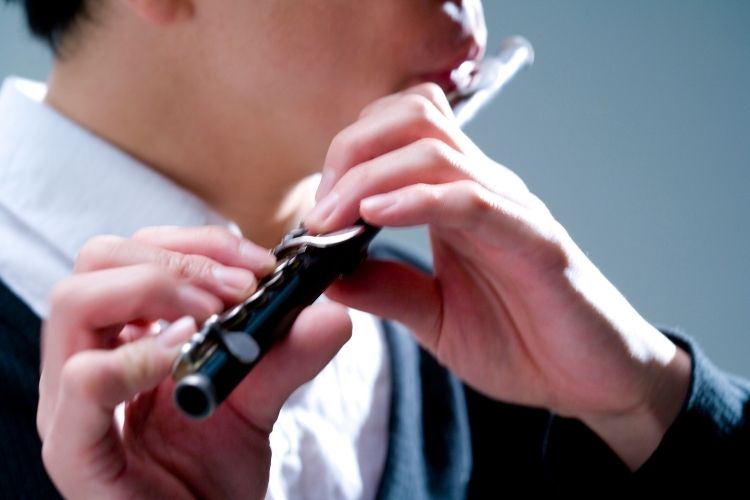
If you want to get serious about playing the piccolo, it doesn’t hurt to upgrade to a professional model. Like with the concert flute, a professional piccolo has more features and specs to help with your playing.
Here are some specs that you won’t find on an intermediate piccolo.
- Solid silver keys
- High G# mechanism
- C# trill
- Vented C key
Most professional piccolos use grenadilla wood (African blackwood), but some use cocus wood or other exotic woods. Some professional piccolos can also go down to a C or B below the typical low D.
FAQs
Answer: Depending on how you count flutes, there are tons of types that exist. You have at least five common members of the concert flute family, but you also have flutes from other eras, where originals or replicas exist.
If you include non-concert flutes, there are flutes like the recorder or the fife. And many regions around the world have at least one type of flute they use. There are at least a few dozen types of flutes out there.
Answer: When looking at the overall history of the flute, it dates back to Germany over 40,000 years ago. The modern metal flute also comes from Germany, though it’s only a couple hundred years old.
Answer: If you include the prehistoric flutes, it’s unclear who invented the first one. People living during that era decided to carve holes in bone or ivory, and the flute was born.
When counting the Baroque flute, Jacques Hotteterre and his family invented it. However, Theobald Boehm invented the modern metal flute.
Answer: The easiest flute to play out of the concert flute family is probably the concert flute. It’s not too small and not too big, and there are tons of beginner flutes out there to use to learn.
On the other hand, the recorder or the tin whistle is probably the easiest when you include all types of flutes. You don’t need to form your lips perfectly, so you can get a sound quickly.
Answer: The most famous living flute player of the classical tradition is James Galway. Other famous flute players in history include Jean-Pierre Rampal, Marcel Moyse, and Paul Taffanel, all from France.
If you include flute players who aren’t classical musicians, the most famous would probably be Ian Anderson of Jethro Tull or the singer Lizzo.
Answer: People who play the flute can go by many names, including flutist, flautist, and flute player. Flutist is more common in the United States, while people in the United Kingdom tend to use flautist.
However, the UK flute player Trevor Wye explains in his book “Proper Flute Playing,” “we should try flutist; it’s simpler, self-explanatory, and widely understood.”
Final Note on the History and Types of Flutes
The flute is one of the oldest instruments in the world, and it’s come a long way in 43,000 years. From bird bone to silver and grenadilla wood, the flute has become an important part of the woodwind family.
Instruments like the piccolo and alto flute have also gained prominence. And if the concert flute family isn’t for you, there are flutes from all over the world with different designs and sounds.


